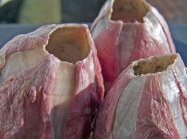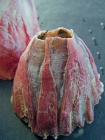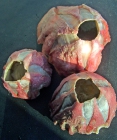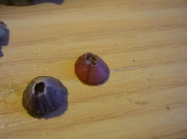WoRMS taxon details
Megabalanus coccopoma (Darwin, 1854)
marine
Darwin, C. (1854). A Monograph on the Sub-Class Cirripedia with Figures of All the Species. The Balanidae, (or Sessile Cirripedia); the Verricidae, etc., etc., etc. <em>The Ray Society, London.</em> i-viii + 1-684, pls. 1-30., available online at https://ia600409.us.archive.org/30/items/monographonsubcl02darw/monographonsubcl02darw.pdf [details] 
Distribution This species originates from the tropical eastern Pacific coasts of Central and South America.
Distribution This species originates from the tropical eastern Pacific coasts of Central and South America. [details]
WoRMS (2024). Megabalanus coccopoma (Darwin, 1854). Accessed at: https://www.marinespecies.org/aphia.php?p=taxdetails&id=149682 on 2024-07-26
Date
action
by
![]() The webpage text is licensed under a Creative Commons Attribution 4.0 License
The webpage text is licensed under a Creative Commons Attribution 4.0 License
original description
Darwin, C. (1854). A Monograph on the Sub-Class Cirripedia with Figures of All the Species. The Balanidae, (or Sessile Cirripedia); the Verricidae, etc., etc., etc. <em>The Ray Society, London.</em> i-viii + 1-684, pls. 1-30., available online at https://ia600409.us.archive.org/30/items/monographonsubcl02darw/monographonsubcl02darw.pdf [details] 
context source (Introduced species) Katsanevakis, S.; Bogucarskis, K.; Gatto, F.; Vandekerkhove, J.; Deriu, I.; Cardoso A.S. (2012). Building the European Alien Species Information Network (EASIN): a novel approach for the exploration of distributed alien species data. <em>BioInvasions Records.</em> 1: 235-245., available online at http://easin.jrc.ec.europa.eu [details] Available for editors [request]
[request]
context source (Schelde) (2010). Bedreiging voor biodiversiteit. Indicatoren voor het Schelde-estuarium. <em>Opgemaakt in opdracht van Afdeling Maritieme Toegang, projectgroep EcoWaMorSe, Vlaams Nederlandse Scheldecommissie. VLIZ Information Sheets, 200. Vlaams Instituut voor de Zee (VLIZ): Oostende.</em> 7 pp. (look up in IMIS) [details]
basis of record Kerckhof, F. (2002). Barnacles (Cirripedia, Balanomorpha) in Belgian waters, an overview of the species and recent evolutions, with emphasis on exotic species. <em>Bull. Kon. Belg. Inst. Natuurwet. Biologie.</em> 72 (Suppl.):: 93-104. (look up in IMIS) [details]
additional source Muller, Y. (2004). Faune et flore du littoral du Nord, du Pas-de-Calais et de la Belgique: inventaire. [Coastal fauna and flora of the Nord, Pas-de-Calais and Belgium: inventory]. <em>Commission Régionale de Biologie Région Nord Pas-de-Calais: France.</em> 307 pp., available online at http://www.vliz.be/imisdocs/publications/145561.pdf [details]
additional source Gittings, S. R. 2009. Cirripedia (Crustacea) of the Gulf of Mexico, Pp. 827–836 in Felder, D.L. and D.K. Camp (eds.), Gulf of Mexico–Origins, Waters, and Biota. Biodiversity. Texas A&M Press, College Station, Texas. [details]
additional source Lutaenko, K.A.; Furota, T.; Nakayama; S.; Shin, K.; Xu, J. (2013). Atlas of Marine Invasive Species in the NOWPAP Region. Beijing: NOWPAP DINRAC (Northwest Pacific Action Plan, Data and Information Network Regional Center). 189 pp. [details]
context source (Introduced species) Katsanevakis, S.; Bogucarskis, K.; Gatto, F.; Vandekerkhove, J.; Deriu, I.; Cardoso A.S. (2012). Building the European Alien Species Information Network (EASIN): a novel approach for the exploration of distributed alien species data. <em>BioInvasions Records.</em> 1: 235-245., available online at http://easin.jrc.ec.europa.eu [details] Available for editors
context source (Schelde) (2010). Bedreiging voor biodiversiteit. Indicatoren voor het Schelde-estuarium. <em>Opgemaakt in opdracht van Afdeling Maritieme Toegang, projectgroep EcoWaMorSe, Vlaams Nederlandse Scheldecommissie. VLIZ Information Sheets, 200. Vlaams Instituut voor de Zee (VLIZ): Oostende.</em> 7 pp. (look up in IMIS) [details]
basis of record Kerckhof, F. (2002). Barnacles (Cirripedia, Balanomorpha) in Belgian waters, an overview of the species and recent evolutions, with emphasis on exotic species. <em>Bull. Kon. Belg. Inst. Natuurwet. Biologie.</em> 72 (Suppl.):: 93-104. (look up in IMIS) [details]
additional source Muller, Y. (2004). Faune et flore du littoral du Nord, du Pas-de-Calais et de la Belgique: inventaire. [Coastal fauna and flora of the Nord, Pas-de-Calais and Belgium: inventory]. <em>Commission Régionale de Biologie Région Nord Pas-de-Calais: France.</em> 307 pp., available online at http://www.vliz.be/imisdocs/publications/145561.pdf [details]
additional source Gittings, S. R. 2009. Cirripedia (Crustacea) of the Gulf of Mexico, Pp. 827–836 in Felder, D.L. and D.K. Camp (eds.), Gulf of Mexico–Origins, Waters, and Biota. Biodiversity. Texas A&M Press, College Station, Texas. [details]
additional source Lutaenko, K.A.; Furota, T.; Nakayama; S.; Shin, K.; Xu, J. (2013). Atlas of Marine Invasive Species in the NOWPAP Region. Beijing: NOWPAP DINRAC (Northwest Pacific Action Plan, Data and Information Network Regional Center). 189 pp. [details]
 Present
Present  Present in aphia/obis/gbif/idigbio
Present in aphia/obis/gbif/idigbio  Inaccurate
Inaccurate  Introduced: alien
Introduced: alien  Containing type locality
Containing type locality
From regional or thematic species database
Introduced species impact United States part of the North Atlantic Ocean (Marine Region) Other impact - undefined or uncertainThe nonnative species influenced settlement, growth and survival of C. virginica in different ways. M.
coccopoma and P. viridis negatively influenced larval settlement, whereas M. charruana had no influence on
the total number of settled larvae. [details]
Introduced species impact Brazilian part of the South Atlantic Ocean (Marine Region) Loss of aquaculture/commercial/recreational harvest or gain (associated with a reduction in size and weight on farmed Perna perna mussels) [details]
Introduced species population trend in Gulf of Mexico (IHO Sea Area) : Perreault (2004) found additional non-recruiting and/or dead populations at this location. [details]
Introduced species population trend in North Sea (IHO Sea Area) : Francis Kerckhof considers this species to be established in the southern North Sea (Kerckhof 2006, personal communication). [details]
Introduced species vector dispersal United States part of the North Atlantic Ocean (Marine Region) Ships: accidental with ballast water, sea water systems, live wells or other deck basins [details]
Introduced species vector dispersal United States part of the North Atlantic Ocean (Marine Region) Ships: accidental as attached or free-living fouling organisms [details]
Introduced species vector dispersal in France (Nation) : Shipping [details]
Introduced species vector dispersal in Belgian part of the North Sea: Ships: accidental as attached or free-living fouling organisms [details]
Introduced species vector dispersal in Belgian part of the North Sea: Ships: accidental with ballast water, sea water systems, live wells or other deck basins [details]
Introduced species vector dispersal Galapagos part of the South Pacific Ocean (Marine Region) Ships: accidental with ballast water, sea water systems, live wells or other deck basins
[details]
Introduced species vector dispersal Galapagos part of the South Pacific Ocean (Marine Region) Ships: accidental as attached or free-living fouling organisms
[details]
From other sources
Alien species The titan acorn barnacle or Megabalanus coccopoma originally only occurred along the west coasts of Central- and South-America. This barnacle was observed for the first time in Europe in 1851, on the hull of a ship moored at Le Havre, France. In Belgium, the titan acorn barnacle was first observed on buoys on the coast in 1997. It is an opportunistic species and is part of the fouling community on ships hulls and other hard substrates. It also competes with indigenous barnacles. [details]Distribution This species originates from the tropical eastern Pacific coasts of Central and South America. [details]
| Language | Name | |
|---|---|---|
| Dutch | grote roze zeepok | [details] |
| English | titan acorn barnacle | [details] |
| Japanese | ココポーマアカフジツボ | [details] |
To Barcode of Life (8 barcodes)
To Biodiversity Heritage Library (2 publications)
To Biological Information System for Marine Life (BISMaL)
To European Nucleotide Archive, ENA (Megabalanus coccopoma)
To GenBank (95 nucleotides; 88 proteins)
To Global Biotic Interactions (GloBI)
To Information system on Aquatic Non-Indigenous and Cryptogenic Species (AquaNIS)
To Niet-inheemse soorten Belgisch deel Noordzee en aanpalende estuaria (in Dutch)
To PESI
To USNM Invertebrate Zoology Arthropoda Collection (16 records)
To ITIS
To Biodiversity Heritage Library (2 publications)
To Biological Information System for Marine Life (BISMaL)
To European Nucleotide Archive, ENA (Megabalanus coccopoma)
To GenBank (95 nucleotides; 88 proteins)
To Global Biotic Interactions (GloBI)
To Information system on Aquatic Non-Indigenous and Cryptogenic Species (AquaNIS)
To Niet-inheemse soorten Belgisch deel Noordzee en aanpalende estuaria (in Dutch)
To PESI
To USNM Invertebrate Zoology Arthropoda Collection (16 records)
To ITIS




